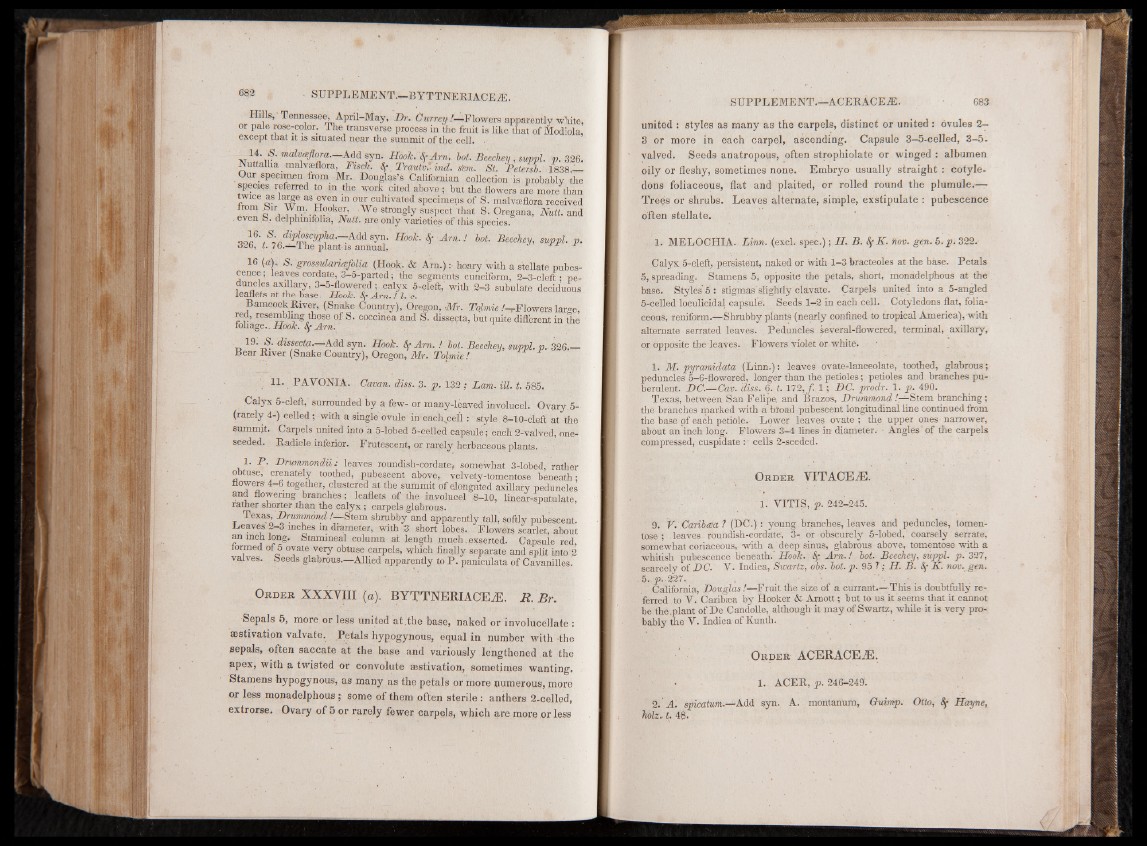
Hills,' Tennessee, April-May, Dr. Currey /—Flowers apparently white,
or pale rose-color. The transverse process in the fruit is like that of Modiola,
except that it is situated near the summit of the cell. •
14. S. malvceflora— Add syn. Hook. 8^ Am. lot. Beechey, suppl. p. 336.
Nuttallia _ malvaflora, Fisch, &f Trautv- ind. s‘em. St. Petersb. 1838—
Our specimen from Mr. Douglas’s Californian collection is probably the
species referred to m the work cited above ; but the flowers are more-7than
twice as large as even m our cultivated specimens of S. malvreflora received
from .bur Wm. Hooker, We strongly suspect that S. Oregana, Nutt, and
. even b, delphmifoha, Nutt, are only varieties of this species.
Add syn. Hook. 8f A m .! lot. Beechey, suppl. p.
326, t. 76— The plant-is annual, *
16 (at. & grossularicefolia (Hook- & Am.) :• hoary with a stellate pubescence
; leaves cordate, 3-5-parted; the segments cuneiform, 2-3-cleft ; peduncles
axillary, 3-5-flowered ; calyx 5-cleft, with 2-3 subulate deciduous
leaflets at the base. Hook. 8f A m .! 1. c.
Bamcock River, (Snake Country), Oregon, Mr. ToJ,mie /-rFlowers large,
red, resembling those of S. coccinea and S. dissecta, but quite different in the
foliage.. Hook. 8f Am. ! '
. 19* _S. dissecta■—Add syn. Hook. Am. ! lot. Beechey, suppl. p. 326.__
Bear River (Snake Country), Oregon, Mr. Tolmie!
11. PAVONIA. Cavan, diss. 3. p. 132 ; Lam. ill. t. 585.
Calyx 5-cleft, surrounded by a few- or many-leaved involucel. Ovary.5-
(raxely 4-) celled; with a single ovule in-each^cell : style 8-10-cleft at the
summit. Carpels united into a 5-lobed 5-celled capsule; each 2-valved, one-
seeded. Radicle inferior. Frutescent, or rarely herbaceous plants.
1. P . Drummondii; leaves roundish-cordate* somewhat 3-lobed, rather
obtuse, crenately toothed, pubescent above, velvety-tomentose beneath;
flowers- 4-6 together, clustered at the summit of elongated axillary peduncles
and flowering branches; leaflets of the involucel 8-10, linear-spatulate,
rather shorter .than the calyx; carpels glabrous.
Texas, Drummond /—Stem shruhby and apparently tall, softly pubescent.
Leaves' 2-3 inches in diameter, with 3 short lobes. Flowers scarlet, about
an inch long. Stamineal column at length much. exserted. Capsule red,
formed of 5 ovate very obtuse carpels, which finally separate and split into 2
valves. Seeds glabrous— Allied apparently to P . paniculata of Gavapilles.
Or d e r XXXVIII (a ). BYTTNERIACErE. R . B r .
Sepals 5, more or less united at .the base, naked or involucellate :
aestivation valvate. Petals hypogynous, equal in number with the
sepals, often saccate at the base and variously lengthened a t the
apex, with a twisted or convolute aestivation, sometimes wanting.
Stamens hypogynous, as many as the petals or more numerous, more
or less monadelphous ; some of them often sterile : anthers 2-celled,
extrorse. Ovary of 5 or rarely fewer carpels, which are more or less
united : styles as many as the carpels, distinct or u n ite d : ovules 2—
3 or more in each carpel, ascending. Capsule 3—5-celled, 3-5-
valved. Seeds anatropous, often strophiolate or winged : albumen
oily or fleshy, sometimes none. Embryo usually straight : cotyledons
foliaceous, flat and plaited, or rolled round the plumule.—
Trees or shrubs. Leaves alternate, simple, exstipulate : pubescence
often stellate.
1. MELOCHIA. Linn. (excl. spec.); I I . B . 8 fK . nov. gen. 5. p. 322.
Calyx 5-cleft, persistent, naked or with 1-3 bracteoles at the base. Petals
5, spreading. Stamens 5, opposite the petals, short, monadelphous at the
base. Styles 5 : stigmas slightly clavate. Carpels united into a 5-angled
5-celled loculieidal capsule1. Seeds 1—2 in each cell. Cotyledons flat, foliaceous,
reniform.—Shrubby plants (nearly confined to tropical America), with
alternate serrated leaves. Peduncles several-flowered, terminal, axillary,
or opposite the leaves. Flowers violet or white.
1. M. pyramidata (Linn.): leaves ovate-lanceolate, toothed, glabrous;
peduncles 5-6-flowered, longer than the petioles; petioles and branches pu-
berulent. DC.—Cav. diss. 6. it. 172, ƒ. 1; DC. prodr. 1. p. 490.
Texas, between San Felipe. and Brazos, Drummond /—Stem branching;
the branches marked with a broad pubescent longitudinal line continued from
the base of each petiole. Lower leaves ovate; the upper ones narrower,
about an inch long. Flowers 3-4 lines in diameter. • Angles of the carpels
compressed, cuspidate :1 cells 2-seeded.
Or d e r VITACErE.
1. VITIS, p. 242-245.
9. V. Caribeea ? (D C .): young branches, leaves and peduncles, tomen-
tose ; leaves roundish-cordate, 3- or obscurely 5-lobed, coarsely serrate,
somewhat coriaceous, with a deep sinus, glabrous above, tomentose with a
whitish pubescence beneath.' Hook. &f. A m .! lot. Beechey, suppl. p. 327,
scarcely of DC. V. Indica, Swartz, obs. lot. p. 95 T; II. B. 8f K. nov. gen.
5. p. 227. . •
California, Douglas!—Fruit the size of a currant.—This is doubtfully referred
to V. Caribaea by Hooker & Arnott; but to us it seems that it cannot
be the .plant of De Candolle, although it may of Swartz, while it is very probably
the V. Indica of Kunth.
Or d e r ACERACEiE.
1. ACER, p. 246-249'.
2. A. spicatum.—M d syn. A. montanum, Guirnp. Otto, 8f Hayne,
holz. t. 48.